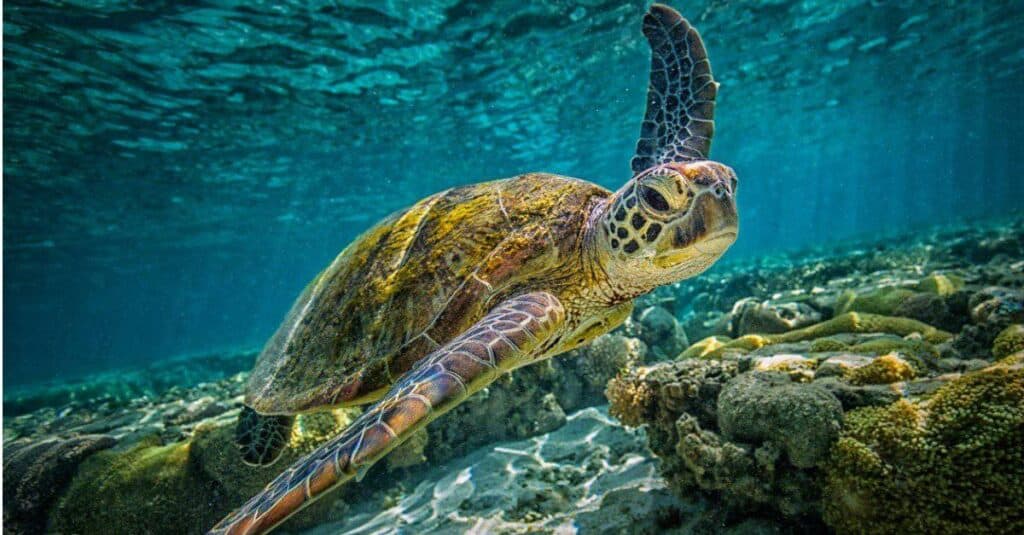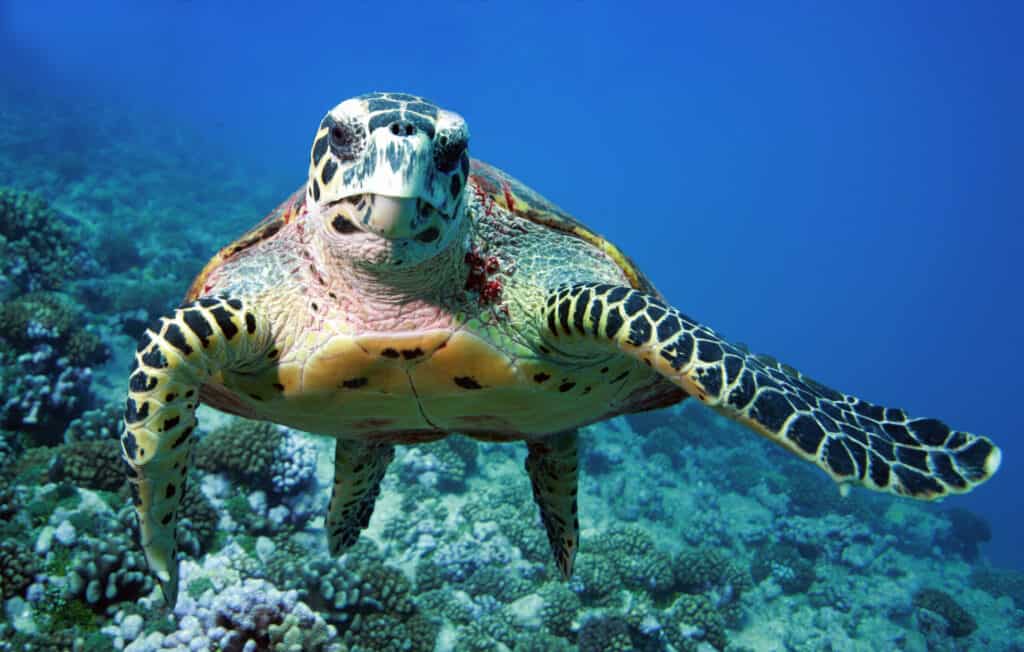With so many species of turtles worldwide, we can safely assume they don’t all have the same diet. Perhaps you’re interested in having a turtle as a pet and are curious about what they eat.
Although we’ll focus on sea turtles, we’ll dive into everything there is to know about what turtles eat and more!
Facts to Consider

The type of jaw a turtle has is a strong determinator of what it can eat and where it dwells.
©iStock.com/Greg Sullavan
Sea turtles are reptiles and comprise approximately 300 species, each having a different favored diet. Certain turtles exclusively eat vegetarian fare, while others devour meat. The bulk of turtles are omnivores and eat both plants and animals.
The type of jaw a turtle has is a strong determinator of what it can eat and where it dwells. Many sea turtles travel long distances in search of food. The leatherback sea turtle has been tracked crossing the Pacific Ocean from Asia to the US West coast to graze on jellyfish swarms along the beaches.
Digestive System of Turtles
According to various researchers, the digestive tracts of humans and turtles only differ slightly. Like sea turtles, humans have the same organs as turtles, which perform the same functions. Turtles have a smaller digestive system, and their trachea, where food enters the stomach, is much longer.
The turtle utilizes the same digestive system as most other vertebrates, but it has evolved to survive with little access to food and water. In general, turtles’ digestive systems work slowly.
Their slow digestion ensures proper microbial breakdown to reap all the nutrients and better gut absorption.
Mouth and Jaw of a Sea Turtle

Due to their powerful, enormous jaws, loggerhead turtles can destroy hard-shelled prey like conchs and whelks.
©Achimdiver/Shutterstock.com
Depending on their unique food, sea turtles have different lips and jaws. Green sea turtles can rip seagrasses and scratch algae off of rough surfaces with the help of their beaks, which contain finely serrated edges that resemble saw teeth.
Because of their powerful, enormous jaws, loggerhead turtles can destroy hard-shelled prey like conchs and whelks. Leatherbacks can puncture and grasp onto jellyfish thanks to the strong, pointed cusps on their jaws.
Additionally, sea turtles have papillae, which are downward-curving spines found in their mouth and throat to help transfer food to their stomach. Adult diets are different from those of hatchlings.
Hatchlings consume a wide range of prey, such as pelagic mollusks and crustaceans (such as larval crabs), hydrozoans (corals and jelly-related organisms), fish eggs, seaweed, and jellies. Unlike herbivorous adults, green hatchlings consume a range of prey while they are young turtles.
Sea Turtle Diet
Despite their status as omnivores when young, sea turtles are considered vegetarians as adults. You’ll find that their main food sources are algae, seaweed, and seagrasses. With their sharply serrated (saw-like) beaks, green sea turtles can shred grasses and seaweed and brush algae off rocks.
Because they only consume jellyfish and soft-bodied invertebrates such as tunicates and sea squirts, leatherbacks are frequently called “gelatinivores.” They can kill jellyfish and other soft-bodied species because of their two cusps on the top and bottom jaw.
Most flatbacks are carnivores, preying on soft bottoms in shallow waters. Although the lifespan diet of this species is unknown, juveniles and adults have been observed to consume snails, jellyfish, corals, and other soft-bodied invertebrates.
As carnivorous creatures, loggerheads devour crabs, conchs, whelks, and horseshoe crabs. Being omnivores, baby turtles eat both plants and animals. The huge skull and strong jaws of loggerhead turtles allow them to crack open hard-shelled surfaces.
Hawksbill turtles are regularly referred to as spongivores due to their diet, which is mainly sponges and hawksbills. The hawksbill’s pointed, minuscule “bird-like” beak allows it to squeeze inside gaps in the coral.
Green turtles are omnivorous as hatchlings, consuming jellyfish, snails, crabs, and shrimp. Green turtles are vegetarian as adults and prefer seagrasses, seaweed, and algae.
Because sea turtles are considered endangered animals, you cannot keep one as a pet. As most of them are protected and thus grow to be large adults, providing adequate space in a simple aquarium in your home would be challenging.
What Do Pet Turtles Eat?

Your turtle’s ideal diet will vary depending on its size, species, age, and living environment.
©Elina Leonova/Shutterstock.com
Turtles make unusual pets. They are captivating, and there’s always something new to learn. Without a proper feeding schedule, your turtle may become ill or even perish, so it’s critical to know what to feed it, when to feed it, and what to do if it doesn’t eat.
Your turtle’s ideal diet will vary depending on its size, species, age, environment, and other factors. Most domesticated turtles are omnivores, which means they consume meat and vegetation. Vegetables, fruits, and animal products should all be a part of a regular adult pet turtle’s diet.
Adolescent turtles between seven and ten years old typically need a larger share of animal-based nutrition. A pet turtle requires a certain combination of animal and vegetable meals.
Food Sources for Turtles
Turtles can be fed animal-based pet products like trout chow and turtle pellets or manufactured canned goods like drained sardines. Additionally, you can give them roasted chicken, beef, and turkey. Larvae, crickets, prawns, krill, feeder fish, and worms are examples of live prey. Only buy insects from a pet store or an unspoilt area, or raise your own to ensure maximum quality and safety.
A pet turtle should eat green leafy vegetables like mustard greens, collard greens, and dandelion greens. You should avoid veggies that contain high quantities of oxalates, including chives, parsley, and arugula.
Some fruits they make enjoy include:
- Cantaloupe
- Mango
- Apple
- Berries
- Banana
These reptiles enjoy aquatic plants like water hyacinth, duckweed, and lettuce!
Pet Turtle Feeding Guide
Regarding eating habits, aquatic turtles and land turtles have different needs. You must put food in their water tank because aquatic turtles can only eat while submerged in water.
Put the food for your land turtle on turf or a smooth, hard object like a rock. To prevent the turtle from only eating one type of food while neglecting other nutrient-rich plants they might not enjoy as much, some turtle caregivers also prefer to chop various veggies.
Depending on the species, your pet turtle will require different quantities of food. As a general guideline, only let your turtle consume as much as it can within 20 minutes and discard any leftovers, particularly for kibble and other non-living meals. Though this might vary based on the species, serve an adult turtle once per day and a young turtle one to two times per day.
Feeding Wild Turtles

Most wild turtles can be fed carrots, romaine lettuce, apples, and bananas.
©Ingrid Curry/Shutterstock.com
As stated by the World Wide Fund for Nature, jellyfish and sea squirts make up the majority of the diet of leatherback sea turtles. So, according to VCA Animal Hospitals, red-eared slider turtles enjoy eating earthworms, snails, slugs, and leafy greens. According to National Geographic Kids, land turtles eat fruit, grass, insects, and beetles.
It might be enticing to feed a turtle while taking a stroll in nature. In general, you shouldn’t handle a wild turtle because it may have salmonella, which is contagious to humans. Most wild turtles can be fed carrots, romaine lettuce, apples, and bananas if you can’t help yourself and feel like you need to give these reptiles a snack.
Up Next
- Sea Turtle vs Land Turtle: What Are The Differences?
- Types of Pond Turtles
- Turtle Lifespan: How Long Do Turtles Live?
- How Old Is the World’s Oldest Turtle? 5 Turtles that Survived for Centuries
The photo featured at the top of this post is © iStock.com/Greg Sullavan
Thank you for reading! Have some feedback for us? Contact the AZ Animals editorial team.






